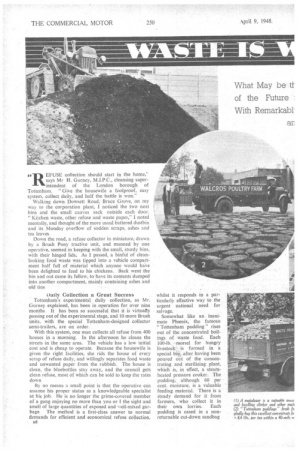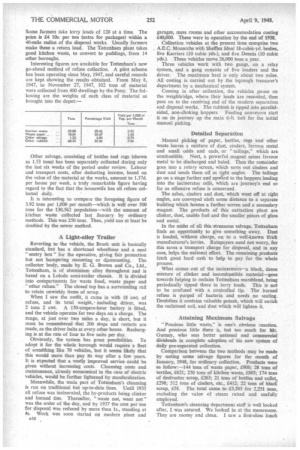114 EFUSE collection should start in the home,"
Page 42

Page 44

Page 47

If you've noticed an error in this article please click here to report it so we can fix it.
says Mr H. Gurney, M.I.P.C., cleansing super intendent of the London borough of Tottenham. "Give the housewife a foolproof, easy system, collect daily, and half the battle is won."
Walking down Dowsett Road, Bruce Grove, on my Way to the corporation plant, I noticed the two neat bins and the small canvas sack outside each door. "Kitchen waste, other refuse and waste paper," I noted mentally, and thought of the more usual battered dustbin and its Monday overflow of sodden scraps, ashes and tea leaves.
Down the road, a refuse collector in miniature, drawn by a Brush Pony tractive unit, and manned by one operative, seemed in keeping with the small, sturdy bins, with their hinged lids, As I passed, a binful of cleanlooking food waste was tipped into a vehicle compartment half full of material which anyone would have been delighted to feed to his chickens. Back went the bin and out came its fellow, to have its contents dumped into another compartment, mainly containing ashes and old tins
Daily. Collection a Great Success
Tottenham's experimental, daily collection, as Mr. Gurney explained, has been in operation for over nine months It has been so successful that it is virtually passing out of the experimental stage, and 10 more Brush units, with the special Tottenham-designed collector semi-trailers, are on order.
With this system, one man collects all refuse from 400 houses in a morning. In the afternoon he cleans the streets in the same area. The vehicle has a low initial cost and is cheap to operate. Because the housewife is given the right facilities, she rids the house of every scrap of refuse daily, and willingly separates food waste and unwanted paper from the rubbish. The house is clean, the bluebottles stay away, and the council gets clean refuse, most of which can be sold to keep the rates down
By no means a small point is that the operative can assume his proper status as a knowledgeable specialist at his job. He is no longer the grime-covered member of a gang enjoying no more than you or I the sight and smell of large quantities of exposed and well-mixed garbage. The method is a first-class answer to normal demands for efficient and economical refuse collection,
B8 whilst it responds in a particularly effective way to the urgent national need for salvage.
Somewhat like an inanimate Phcenix, the famous "Tottenham pudding" rises out of the concentrated boilings of waste food. Each 100-1b. :morsel for hungry livestock is formed in a special bill, after having been poured out of the concentrating and sterilizing plant, which is, in effect, a steamheated pressure cooker. The pudding, although 60 per cent. moisture, is a valuable feeding material. There is a steady demand for it from farmers, who collect it in their own lorries. Each pudding is cased in a nonreturnable cut-down sandbag Some farmers take lorry loads of 120 at a time. The price is £4 10s. per ton (extra for packages) within a 40-mile radius of the disposal works. Usually farmers make these a return load. The Tottenham plant takes good kitchen waste, to convert to puddings, from 14 other boroughs.
Interesting figures are available for Tottenham's new go-ahead method of refuse collection. A pilot scheme has been operating since May, 1947, and careful records are kept showing the results obtained. From May 8, 1947, to November 27, 1947, 102 tons of material were collected from 400 dwellings by the Pony, The following are the weights of each class of material as brought into the depot:—
Other salvage, consisting of bottles and rags (shown as 1.53 tons) has been separately collected during only the last six weeks of the period under review. Labour and transport costs, after deducting income, based on the value of the material at the works, amount to 1.37d. per house per week, a truly remarkable figure having regard to the fact that the housewife has all refuse collected daily.
It is interesting to compare the foregoing figure of 3.92 tons per 1,000 per month—which is well over 500 tons for the 130,562 population—with the amount of kitchen waste collected last January by ordinary methods. This was 250 tons. Thus, yield can at least be doubled by the newer method.
A Light-alloy Trailer Reverting to the vehicle, the Brush unit is basically standard, but has a shortened wheelbase and a neat "sentry box" for the operative, giving fair protection but not hampering mounting or dismounting. The collector body, made by E. G. Brown and Co., Ltd., Tottenham, is of aluminium alloy throughout and is based on a Lolode semi-trailer chassis. It is divided into coMpartments for waste food, waste paper and "other refuse." The closed top has a surrounding rail to retain unwieldy items of scrap.
When I saw the outfit, it came in with 18 cwt. of refuse, and its total weight,including driver, was 2 tons 2 cwt. A 150-ampere-hour battery is fitted, and the vehicle operates for two days on a charge. The range, at just over two miles a day, is short, but it must be remembered that 200 stops and restarts are made, as the driver halts at every other house. Recharging is at the rate of four to five units per day.
Obviously, the system has great possibilities. To adopt it for the whole borough would require a fleet of something like 70 vehicles, but it seems likely that this would more than pay its way after a few years. It is expected that a vastly improved service could be given without increasing costs, Cleansing costs and maintenance, already economical in the case of electric vehicles, would be further lightened by standardization.
Meanwhile, the main part of Tottenham's cleansing is run on traditional but up-to-date lines. Until 1935 all refuse was incinerated, the by-products being clinker and burned tins. Thereafter, "waste not, want not" was the order of the day, and by 1937 the cost per ton for disposal was reduced by more than is., standing at 4s. Work was soon started on modern plant and a 10
garages, mess rooms and other accommodation costing £40,000. These were in operation by the end of 1938. Collection vehicles at the present time comprise two _ A.E.C. Monarchs with Shefflex Ideal 18-cubic-yd. bodies, five Karriers (10 cubic yds.), and five Dennis (10 cubic yds.). These vehicles move 26,000 tons a year.
Three vehicles work with two gangs, on a relay system, and a gang consists of five loaders and the driver. The maximum haul is only about two miles. All costing is carried out by the bqrough treasurer's department by a mechanical system.
Coming in after collection, the vehicles pause on the weighbridge, where their loads are recorded, then pass on to the receiving end of the modern separation and disposal works. The rubbish is tipped into parallelsided, non-choking hoppers. Feeding conveyors start it on its journey up the main 6-ft. belt for the initial manual picking.
Detailed Separation
Manual picking of paper, bottles, rags and other waste leaves a mixture of dust, cinders, ferrous metal and small odds and ends, or "tailings," which are combustible. Next, a powerful magnet seizes ferrous metal to be discharged and baled. Then the remainder goes into a rotary screen, which sorts out cinders and dust and sends them off at right angles. The tailings go on a stage further and upward to the hoppers leading into the incinerator cells, which are journey's end so far as offensive refuse is concerned.
The ashes, cinders and dust, which went off at right angles, are conveyed aloft some distance to a separate building which houses a further screen and a secondary magnet. The products of this extraction plant are clinker, dust, usable fuel and the smaller pieces of glass and metal.
In the midst of all this strenuous salvage, Tottenham finds an opportunity to give something away. Dust is loaded, without charge, on to a well-known tirick manufacturer's lorries. Ratepayers need not worry, for this saves a transport charge for disposal, and in any case, helps the national effort. The remaining products fetch good hard cash to help to pay for the whole process.
What comes out of the incinerators—a black, dense mixture of clinker and incombustible material—goes towards helping to reclaim Tottenham marshland, being periodically tipped there in lorry loads. This is not to be confused with a controlled tip. The burned refuse is purged of bacteria and needs no sealing. Doubtless it contains valuable potash, which will enrich the reclaimed soil, and dust which will lighten it.
Attaining Maximum Salvage Precious little waste," is one's obvious reaction. And precious little there is, but too much for Mr. Gurney, who sees better national and commercial dividends in complete adoption of his new system of daily pre-separated collection.
Comparison between the two methods may be made by noting some salvage figures for the month of January, 1948, for ordinary collection. Products were as follow:-144 tons of waste paper, £900; 28 tons of textiles, £621; 250 tons of kitchen waste, £805; 174 tons of destructor scrap, £263; 21 tons of bottles and cullet, £298; 512 tons of cinders, etc., £412; 22 tons of black scrap, £58. The total came to £3,503 for 2,251 tons, excluding the value of steam raised and usefully employed.
Tottenham's cleansing department staff is well looked after, I was assured. We looked in at the rnessrooms. They are roomy and clean. I saw a first-class lunch which was going to cost someone less than a shilling. There are 90 employees in the works, 46 on refuse collection and 60 on street cleansing and gully-emptying.
Vehicles for street cleansing are three Karrier Bantams and a Lewin sweep-collector. Two Dennis gully-emptiers are employed, and two A.E.C. Monarchs are used exclusively for transporting burned refuse from the 'works to the disposal point. They are loaded by two Chaseside mechanical shovels on Fordson Major tractors. Another Fordson Major is fitted with a muledozer and used for compressing, levelling and so on.
Maintenance of these vehicles is carried out as part of an overall scheme to keep in good repair the whole council fleet of 77 vehicles. There is thus a certain degree of centralization of Tottenham's transport, particularly as regards costing and maintenance. Garaging, however; is at departments. Machine-tool equipment is good. There are 8-in. and 6i-in. lathes, a shaping machine, mechanical saw, two grinders and two vertical drills. Specialized machining, such as cylinder boring and crank grinding, is sent out.
saw little repair work in progress while 1 was there. That is a good sign. Vehicles should be on the road and not in the garage. It must be remembered also that cleansing vehicles do not cover great mileages and are in service for long periods between docks. The fleet is kept in good shape by weekly greasing and cleaning. A top-and-bottom. overhaul may come once in 12-18 months.




















































































